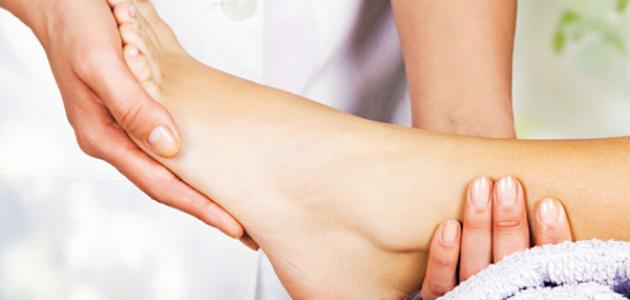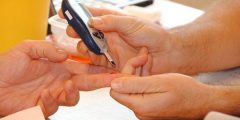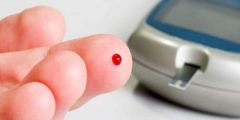The effect of diabetes on the feet
The diabetic patient suffers from problems affecting his feet and legs, caused by high sugar levels, which are believed to lead to nerve damage, causing neuropathy, which in turn leads to a loss of sensation in the feet, and thus the patient does not feel the wounds and pain occurring in the feet. The feet, which develop into many problems, including calluses, ulcers, and bunions; Which is represented by the formation of bone spurs on the joint at the base of the big toe. These problems may develop due to high blood sugar levels and become infected, which, if left untreated, causes gangrene, which may require an amputation.
How to take care of diabetic feet
It is recommended to follow the following to care for diabetic feet and avoid the occurrence of various problems:
- Wash and dry your feet daily: It is recommended to use gentle soap, lukewarm water, and dry the feet well. Therefore, because humidity is a suitable environment for infection, it is good to apply lotion after drying the feet to avoid cracking, but you must be careful not to put it between the toes. Check the foot daily: The person can do this himself, or ask for help from any other person, in order to verify that the following are not present:
- Dry or cracked feet.
- Redness or change in color.
- Warmth in the feet or pain when pressing on the foot.
- Wounds, scratches, blisters, or ulcers.
- Taking care of toenails: It is recommended to cut the nails straight after bathing because they are softer, and to use a nail file after that, in addition to the need to be careful to avoid trimming the corners of the nail, or cutting any part of the skin.
- Choose socks and shoes carefully: When choosing socks, it is recommended to choose those made of wool or cotton, which do not contain seams to avoid exposure to friction that causes harm to the skin. Tight socks should also be avoided. What should be noted is the need to change socks daily. It should be noted that patients who suffer from Excessive sweating: It is recommended to change socks several times a day. Speaking of shoes, natural leather and natural fibers are good materials when choosing shoes. It is advised to avoid wearing high-heeled shoes or sandals, or shoes that by their nature separate the big toe from the rest of the toes. You must also make sure The shoe size is appropriate when purchasing, by measuring the two shoes and purchasing based on the size of the big foot. Daily care of the shoes is very important, in order to ensure the integrity of their lining, and the absence of any harsh parts or protrusions in them.
- Do not use your feet to check the temperature of bathing water: Burns on the feet increase the possibility of infection, so it is recommended to use the elbow to check the water temperature instead of the foot.
- Quit Smoking: The chemicals in cigarettes damage and narrow blood vessels, which in turn reduces nutrition and oxygen reaching the feet, thus reducing the effectiveness of fighting infection.
- Diabetes control: This is done by paying attention to the diet followed, checking the blood sugar level periodically, in addition to taking medications and exercising.
- Pay attention when exercising: It is known that exercising is important for a diabetic patient, but some exercises may cause pressure on the feet, so it is recommended to do exercises that do not put pressure on the feet, such as: swimming or walking, with the need to wear appropriate shoes while doing so.
- Activating blood circulation in the feet: This is done by keeping the feet at a high level while sitting, and moving the toes and heels up and down 2-3 times a day, for 5 minutes.
- Regular review of your medical care provider: This step is preventive; As it is necessary to conduct a complete examination of the foot at least once a year, and more than that for those who suffer from foot problems, this also includes the necessity of informing the doctor in the event of any wounds, or the growth of a nail under the skin, or noticing changes in the foot, with the necessity of Warning that the patient should not try to treat corns on his own, and leave this task to the specialist.
doctor review
When some foot problems appear, a diabetic patient must see a doctor, or contact him, preferably within three days. These problems include the following:
Read also:Random sugar analysis- Any damage to the foot or leg, regardless of its size.
- The presence of constant pain of moderate intensity.
- The appearance of any pimple, wound, or ulcer, even if it is small in size, because of the possibility of it developing into a larger problem later.
- The appearance of redness, swelling, or increased temperature in any area of the foot or leg, as these symptoms are considered initial symptoms of inflammation or infection. If the redness and swelling around the nail is accompanied by pain, this is an indication of the growth of a nail under the skin, which Urgent treatment is required.
- The appearance of bunions.
- Suffering from persistent or newly started numbness in the foot, which indicates impaired blood circulation in the foot or the presence of neuropathy.
- Having trouble walking; This is due to inflammation of the joints, caused by pressure on the feet, or by poor shoes worn by the patient.
- The presence of persistent itching in the foot, which indicates dry skin, or a fungal infection, both of which increase the risk of infection.
- Skin color changes to black.
- Suffering from the problem of hammer toe (in English: Hammer toes); The medial joints of the toes are constantly folded downward.
- Suffering from fever, whether it is accompanied by other symptoms or not.









